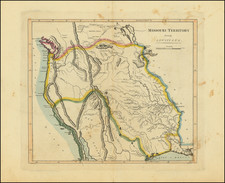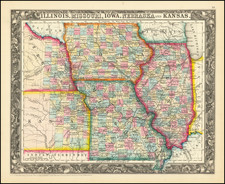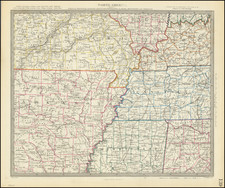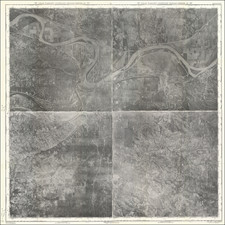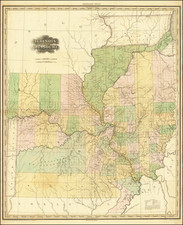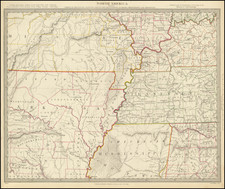A Remarkable Early New Madrid Archive
A rich archive documenting the early years of New Madrid, the first permanent American settlement west of the Mississippi, through the eyes of Andrew Wilson, one of the city’s first settlers. Wilson, a minister-turned-judge, has much to say about religious freedom and the reinvention of government during the transfer of Louisiana to American control. The archive includes one of the earliest-known manuscript plans of New Madrid.
Andrew Wilson, an early and prominent settler at New Madrid
Andrew Wilson (1749/50 – ca. 1819/1820) was a Scottish immigrant and Presbyterian minister who first came to New Madrid with the city’s founder, George Morgan, in 1789. Around 1794, Wilson was granted an in-town lot and 280 arpents of land along the Mississippi. He cleared and farmed 16 acres of the latter. Wilson left New Madrid around 1801, perhaps returning to his family in Pennsylvania, but by 1803 he was on his way back, stopping in Vincennes, Indiana Territory, where he met with Territorial Governor William Henry Harrison.
Wilson was particularly well positioned to comment on the social and governmental tribulations of early New Madrid. For a time, he was a leader in the affairs (and conspiracies) of the city and was in a position to write long letters and petitions to senior American administrators in the West including Harrison as well as Governors William Claiborne of Orleans Territory and Amos Stoddard of Louisiana Territory. By 1806, he was Recorder, Judge of Probate, and Notary Public in the District of New Madrid, and we learn from other sources that his son George was New Madrid’s first sheriff. Wilson’s writings in the archive touch on the confusion about who was even in charge during the handover from the French. Much of Louisiana fell under the temporary jurisdiction of the Indiana Territory until the Territory of Louisiana was established in July 1805, and the handful of American administrators faced great difficulties governing the vast territory.
As a minister, Wilson celebrated the new religious freedom ensured under the Bill of Rights, at other times he complained that in practice local authorities were failing to respect this freedom.
Wilson arrived west of the Mississippi on the bleeding edge of American expansion, and in retrospect, he got there at least a generation too early. Throughout the archive, his initial optimism about the New Madrid project gives way to intractable land disputes and frustrations. His life in New Madrid spanned Spanish colonial rule, the French takeover, the Louisiana Purchase, the District of Louisiana, the Louisiana Territory, and possibly the Missouri Territory, and this complicated his land claims to no end. Indeed, at least one descendant was pursuing those claims at least as late as 1881. Several of the documents bear witness to the bureaucratic nightmare and real hardship occasioned by uncertainty about the continued validity of title to lands granted under the previous Spanish administration of Louisiana.
Late in life, Wilson ended up back East. His personal letters to family members, primarily his son John, suggest that he was a hard and judgmental man, for whom expressions of kindness were almost entirely foreign; that he spent many years away from his wife and children and ultimately became estranged from all but John; and that his last years were marked by bitterness and poverty. The New Madrid Earthquakes of 1811-12 presumably played a role in his move east, as by 1813 he had moved to Charlestown, Virginia (now Wellsburg, West Virginia). In 1819, he was a resident of Washington, Pennsylvania, and that year or the next he died there.
The archive includes a survey of land in New Madrid made on Wilson’s behalf in 1794 (an exceptionally early American survey west of the Mississippi); a group of letters and other material written by Wilson in New Madrid between 1804 and 1806; and another group consisting of letters written by him to his son John between 1813 and 1817 from Charlestown, Virginia, and Washington, Pennsylvania, along with his will dated 1819. Together they enable us to fill out, if not complete, a sketch of Wilson’s character as well as his activities and experiences during his time in New Madrid and thereafter. A full inventory follows in an appendix.
Andrew Wilson’s plan of New Madrid in 1794 and 1803
One highlight of the archive is a plan of New Madrid in 1794 and 1803,also in Wilson’s own hand, but “taken from an old plan begun in 1794 on no certain scale.” The plan is undated, but we believe it to date from 1804-06, contemporary to the cluster of New Madrid documents discussed above. The map is executed on laid paper with a powder horn-(or post horn)-and-strap watermark in a horizontal orientation. Mark Wilcox, the Pennsylvania papermaker is known to have used a similar watermark at the end of the 18th century and beginning of the 19th.
Oriented with north at the upper right, the plan depicts New Madrid situated along the west bank of the Mississippi, bounded to the north by Bayou St. John and Bayou St. Thomas and to the south by Bayou Deroche. The town is laid out largely on the classic grid found in thousands of towns in the American west, though the streets all bear French-language names. Only in the vicinity of the river and Fort Celeste are some of the lots irregularly-shaped, presumably to accommodate local geography. Most of the lots are numbered, from 1 to 286, though the numbering follows no obvious order and may reflect the sequence in which they were recorded in the town’s land-ownership records. Other than Fort Celeste along the river, there is no apparent provision for open space, a court house square or other public accommodations.
A note at top center reads in part, “This taken from an old plan begun in 1794 on no certain scale.” This “old plan” is the unsigned Nouvelle Madrid in Avril 1794 held by the Missouri Historical Society and illustrated in Reps’ The Making of Urban America (fig. 285). Though the 1794 plan is in a different hand, it agrees with ours in almost all respects, down to the location and format of the compass at lower right. The few changes include the projected extension of the street plan to the south and west, the reconfiguring and/or renumbering of a few lots, and the absence of the lake extending south into the town from the Bayou St. Jean.
That same note also tells us that “in 1804 the fort Celeste & the houses [illegible word ending “land”] nearly as far back as streets St. Antoine St. Marguerite and St. Linon[?] nearly from 1794 had fallen into the Mississippi.” Indeed, on a later manuscript plan dated 1810, also unsigned, held by the Missouri Historical Society and illustrated by Reps (fig. 286), the Fort and streets as far inland as rue St. Charles have been washed away. This 1810 plan is also interesting for listing numerous landowners in town (Wilson for some reason not among them) and for abandoning the suburban development envisioned on our plan.
Wilson has not dated the plan, and on it he offers no explanation of either why he drew it or why he shows streets that had been washed away. One possibility is that he sketched it in or around May 1804 to accompany documents he filed relating to confirming his title to lands in and around New Madrid (See document 3 in the “Inventory” section below.) It is possible that the map was somehow connected with his attempt to obtain a new lot in in compensation for the one that had been flooded out.
The origins of New Madrid
In the 1780s Spain held title to the vast region of Louisiana west of the Mississippi as well as navigation rights to the river itself. At the same time, American settlers were flooding westward in the aftermath of the Revolution, and it was only a matter of time before they pushed into the trans-Mississippi West. Spain’s dilemma was how to maintain a semblance of control in Louisiana, which it lacked the resources to colonize or defend.
Spain adopted a two-fold strategy: First, in 1785 it closed navigation on the Mississippi, denying American settlers an outlet for trade. Second, it sought to induce Americans to settle in Louisiana and there become loyal Spanish citizens, in the hope that they would form a reliable barrier to American expansion. One such effort was at New Madrid, founded in 1789 by George Morgan of Kentucky, a prominent former officer in the Continental Army.
Based on an understanding reached with Don Diego de Gardoqui, Spanish Minister to the United States, in early 1789 Morgan led a group of settlers to a site on the west bank of the Mississippi River. For some reason he chose a poor site some 40 miles downriver from the mouth of the Ohio, set on low ground and surrounded by swamp. In any event he envisioned a great western metropolis, a mile square, its orderly grid layout relieved by generous provisions for education, religion and public spaces, including a broad road and parkland around a lake in the northern part of town.
The Spanish governor of Louisiana rejected much of the Gardoqui-Morgan plan, however, and it appears that already by the end of 1789 Morgan had given up on the project and returned to his home in New Jersey. The town remained under control of a Spanish commander, and several hundred Americans, some bringing their slaves, had settled there by the late 1790s. As early plans show, however, the town never remotely approached Morgan’s grand vision, and in fact “actually developed as a convention and rather dreary frontier village.” (Reps, Making of Urban America, p. 480) Then the early 19th century bought repeated disasters: In 1804 a large section of the town was inundated by the Mississippi, and the “New Madrid Earthquakes” of 1811-1812 left it devastated and depopulated. The town survives today, but the original site is entirely underwater.
Inventory of documents
In chronological order. All documents are manuscript in ink on laid paper.
1 Joseph Story, [True copy of a survey of 280 arpents of land on the Mississippi surveyed for Wilson.] New Madrid, November 27, 1794. 1p on bifolium, including a plat of the parcel at top. The parcel is in New Madrid, exactly location not known, but we learn from document 3 (see below) that he acquired it in 1794, that it was commonly known as “Plantation No. 4,” and that “he raised a number of crops having cleared sixteen acres & upwards thereon.”
2 Andrew Wilson, [Drafts or retained copies of five documents.] New Madrid, March-April, 1804. 2pp. Includes among others a petition to “The Governour of Louisiana” complaining that the Commandant of New Madrid has prevented him from holding worship services in a Catholic Church in New Madrid; a warning by Wilson to those “stealing… wood and timber from his plantation No. 4 on the bank of the Mississippi” that they do so at their “peril;” a notice to parents of would-be students at his school in New Madrid; and a cover letter to Amos Stoddardt, Governor of Upper Louisiana, intended to accompany a copy of the aforementioned petition.
3 Andrew Wilson, [Drafts or retained copies of two documents.] New Madrid, March-April, 1804. 2pp. The recto is a retained copy of a letter to his wife, Sarah Wilson, who remained in Pennsylvania. The first paragraph addresses personal matters, mentions two children (John and Franny), and indicates that he had arrived in New Madrid in or around October 1803. The second enthuses about the American takeover of Louisiana (“What a door of usefulness is now opened here_Civil & religious liberty unenjoyed before. Our numbers higher up than New Orleans & Natchez about ten thousand souls daily increasing.”) It also mentions his “teaching & preaching” activities, rapidly rising property values and the uncertain state of local government.
The verso contains a fair copy of a statement dated May 14, 1804 asserting Wilson’s ownership of both Plantation No. 4 (including a copy of the 1794 plat) as well as “lot No. 214 in this village entered by direction of Commandant Peyrouse in the plan & register of the village by [short illegible word] P. Laforge keeper thereof when vacant in lieu of a lot which the subscriber had cleared & built a house on & which had with many others fallen into the river according to the uniform practice of the village in such cases.” Wilson’s property had been inundated in or before 1800. The location of Wilson’s this parcel is not stated, but the plan of New Madrid in 1794 and 1803 included in this archive shows the replacement, lot 214, at the intersection of rue Royalle and rue St. Andre. For some reason, in February 1801 Commandant Peyrouse “arbitrarily & unjustly forbid the subscriber’s building on or inclosing” the lot.
4 Andrew Wilson, [Fair copy of a document.] New Madrid, May 14, 1804. 1p. Almost identical to the statement on verso of document 3.
5 Andrew Wilson, [2 diary entries and drafts or retained copies of 4 documents.] New Madrid, May-July, 1804. 4pp. Includes a copy of Section 14 of “Act erecting Louisiana into two territories [i.e., Orleans Territory and District of Louisiana] & providing for the temporary government thereof.” According to this section all grants of land in the Louisiana Territory made after the Treaty of St. Ildefonso (signed Oct. 1, 1800) and before the handover were “null void & of no effect in law or equity,” unless the grants were “actually settled” prior to December 30, 1803. This Act, passed March 26, 1804, may explain documents 3 and 4 above, which reflect efforts by Wilson to confirm clear title to his New Madrid lands.
Also included in this document are retained copies of more-or-less identical June 14, 1804 letters to Amos Stoddart, Governor of the District of Louisiana; William Claiborne, Governor of the Orleans Territory; and William Henry Harrison, Governor of the Indiana Territory. These are cover letters accompanying two petitions (of which sadly no copies are included in the archive), one respecting objections by the “yeomanry” of New Madrid to the appointment of Pierre Antoine LaForge as Commandant, presumably on account of his many years of prior service under the Spanish government and presumed loyalty thereto.
The other petition seems to have involved Wilson himself, in particular the residents’ wish that he be appointed Commandant and/or Register in New Madrid. Wilson declines the former but embraces the latter: “As I generally did my own business either with French or English people in their respective languages & had been a good deal conversant with papers & records if they desired I could & would serve them as Register[.] I would do it as I do not think that inconsistent with the Clerical character. However after a life of 54 years passing thro’ the American revolution employed both in active & sedentary pursuits seeing a great deal of human vanity I wish to end my days in preparing myself & others for eternity.”
6 Andrew Wilson, [Document, docketed “A” at upper left.] New Madrid, July 2, 1805. 2pp. A copy of a September 3, 1794 petition by Wilson to Louisiana Governor Baron de Carondelet, originally written in Spanish and here accompanied by a translation. Wilson requests “that there may be conceded to him one hundred & eighty square feet of land bounded on one side by lands of Richard Jones Waters on the other by the Alley St. Isabella and fronting on the Mississippi River.” Further text indicates that the petition was backed by Laforge, at the time serving as Recorder, and approved by Carondelet. This village parcel is presumably the parcel 161 shown on Wilson’s plan of New Madrid in 1794 and 1803 and the one referred to in document 3 as having “fallen into the river.”
7 Andrew Wilson, [Document, docketed “B” at upper left.] New Madrid, May 16, 1806. 1p. A fair copy of a December 1, 1794 petition in Spanish by Wilson to Louisiana Governor Baron de Carondelet. Wilson requests a grant of seven arpents on the bank of the Mississippi, between parcels owned by Richard Jones Waters and “Thompson.” The petition is endorsed by Laforge and approved by Carondelet. This is probably the parcel whose survey is recorded in document 1 and referred to elsewhere by Wilson as Plantation No. 4.
8 Andrew Wilson, [Document, docketed “C” at upper left.] New Madrid, May 16, 1806. 1p. A fair copy of a September 23, 1800 petition in Spanish by Wilson to Louisiana Governor Baron de Carondelet. Wilson requests a grant of one arpent of land in the village at the intersection of calle real (aka rue Royalle) and calle Sn. Andrez (aka rue St. Andre). This is the parcel referred to in document 3 as lot 214. The petition is endorsed by Commandant Henri Peyroux, but Carondelet’s response is not here recorded.
9 Philippe Leduc, [Document, docketed “E” at upper edge.] St. Louis, Sept. 2, 1806. 1p, affixed seal affixed, signed by Wilson and witnessed by Leduc. Attests that Wilson had made a good effort to submit in person “his claim” to the Federal commissioners meeting at St. Louis “for ascertaining claims of land” in Louisiana Territory. For reasons not stated, the commissioners had not actually met as promised. Presumably Wilson’s appearance in St. Louis was related to his claims to the parcels in and around New Madrid described in documents 6-8, the validity of which had been called into question following the handover of Louisiana.
10-15 Andrew Wilson, [6 ALS to his son John Wilson.] Charlestown, Brooke County, Virginia, Oct. 1813-June 1817.Each 1 or 2pp, 10pp in all. Wilson corresponds with his son John, a carpenter in Washington, Pennsylvania. Much of the content concerns mundane matters relating to Andrew’s attempts to broker a large shipment of lumber to John, with much fatherly business advice sprinkled in (How this was received, we’ll never know.) In the second letter of the series, dated July 5, 1814, we learn that Wilson is estranged from his wife: “I am sorry for the sickness of James & consequent distress of his mother. He is undoubtedly your brother & an unoffending infant, but owing to the undutiful disorderly & infatuated conduct of his mother his legitimacy or illegitimacy is best known to the Omniscient God & probably at some period of futurity will be made known to us.” Alas, there is much uncertainty here, including whether this wife is the same Sarah Wilson to home he wrote fondly in 1803 (document 3), and whether the apparent infidelity was a cause or effect of the estrangement. By the final letter, of Sept. 10, 1817, Wilson is so ill that he believes himself near death, sufficiently impoverished that he asks his son for financial assistance, and feeling terribly alone, “as if providence would put every intimate acquaintance & friend out of my reach.”
16 Andrew Wilson, [Last will and testament.] Washington, Pennsylvania, Sept. 5, 1819. 1p, signed by Wilson and witnessed by Thomas Morgan and James [last name illegible]. Describing himself as “formerly United States Recorder & Judge of Probate of the District of New Madrid,” Wilson leaves to son John “all & sundry land & lots in the Territory of Missouri & especially in the County of New Madrid by whatever right I hold or have a claim to the same, by any grant donation or concession from either the Spanish or American government & especially by virtue of an act of the United States of America in Congress assembled, approved [Feb. 17, 1815].” This Act was for the relief of New Madrid residents dispossessed by the earthquakes of 1811-12 and entitled them to claim “a like quantity of land on any of the public lands” of the Missouri Territory. It would seem that Wilson, whose once-tidy signature has become a weak scrawl, returned to Washington to die, with his finances in a dire state due at least in part to his losses at New Madrid.
17 John A. Mott, [ALS to Darlie S. Wilson of Washington, Pennsylvania.] New Madrid, Jan. 18, 1881. 2pp on sheet of lined paper. Wilson has written Mott “regarding lands claimed by Andrew Wilson, New Madrid Co.” Mott begins by responding, “Your claim is rather antiquated, and would require a very considerable amount of examination,” goes on to explain the background of the New Madrid Earthquakes and the 1815 Act of Congress, and invites Wilson to send an advance of $10 if he wishes Mott to review the historical records. “But if the heirs of Wilson are not willing to pay any thing, they has as well Chg up this Claim to Profit & loss, which I think likely may be the case in any event.” Unfortunately the archive contains no record of whether Wilson took Mott up on his offer.











